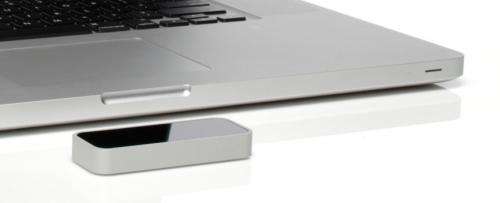May 23, 2012 report
Leap Motion creates finger-happy gesture control (w/ Video)

(Phys.org) -- Developers and end users both have been indicating they are ready to start saying long goodbyes to mouse and keyboard. In this touchscreen generation of mobile users, the big stir among gadget reviewers this week is the announcement by Leap Motion that you can not only say goodbye to mouse and keyboard, but goodbye to touchscreen, too. "That nice LED display remains clean and untouched, as it should be,” says the company. The San Francisco based company has announced it is accepting pre-orders for its new Leap, a small USB peripheral that performs motion control with in-the-air sweeps of hand and movements of fingers. The Leap creates a 3-D interaction space of eight cubic feet to interact with and control software on a laptop or desktop. This gesture-control device for computers is running rings, and orbs, and swirls, and curlicues, around Kinect, the most well known of technologies that help users interact with computers without mouse and keyboard.
Leap’s web site and team comments in interviews all say that Leap is not just any game system to be confused with living-room playing in front of the TV. Rather, Leap founders took some hard work in years to improve on a technology where the individual mobile user can get at information easily. “Two or three hundred thousands lines of code later, we’ve figured out how to use the Leap to create an interaction space around your computer, in 3-D. Able to distinguish thumbs from fingers, and even handheld items like pencils,” according to the company site.
Swipes in the air and nuanced finger gestures zoom and pinch and move pages and manipulate other image feats. Gestures create anything from rings, to orb eruptions, to swirls and curlicues, to handwriting, at times hands seemingly reaching inside the screen to extract content. Leap consists of a USB input device and software platform. Its size is described variously as no bigger than “a packet of chewing gum” to “no bigger than a pocket knife.” The Leap plugs into a USB port. The user loads the Leap Motion software and “waves” to calibrate.
The 3-D motion-control system is available for pre order at $70. The company estimates the units will ship in December this year or January 2013.
The technical strengths do not come from one-off discovery but from tedious years of careful research. The Leap gesture recognition is claimed to be 200 times more accurate than anything else on the market. The other advantage being promoted is comfort. If you have to keep waving your arms around, you quickly tire. With Leap, finger movements are less fatiguing and more efficient. The original inspiration behind Leap came from frustration over 3-D modeling—something taking ten seconds in real life could take 30 minutes with a computer. Molding virtual clay should be as easy as molding real clay, thought the company leaders. They felt that the mouse and keyboard were simply getting in the way.
Leap Motion is presently reaching out to software developers, as developer participation will be important to the product’s growth, The company is accepting applications for software developer kits in the hopes of growing applications available at launch.
More information: www.leapmotion.com/
© 2012 Phys.Org



















